By Gavin Bamford, History Hub Ulster
History
A previous bridge on this site was a privately owned five span masonry bridge which was built in 1831. It was officially called Lagan Bridge, although it was known as Halfpenny Bridge due to the toll charged. It was subsequently renamed to Albert Bridge after Queen Victoria’s husband. In 1860 it was acquired by the Belfast Corporation, which abolished the toll.
Imminent Collapse
The Belfast Corporation Improvement Committee (note 1) met on 8th September 1886:
Albert Bridge – The Surveyor reported that in consequence of the Albert Bridge having shown signs of subsidence and fracture, observations were being taken to determine whether any danger is likely to occur to the public.

The Witness (Belfast) newspaper of 10th September 1886 reported in their local and provincial news column that:
It is stated that the Albert Bridge is sinking, and that it is consequently becoming dangerous for heavy traffic. We understand that the Town Council officials are engaged in examining it.
The Belfast Corporation Improvement Committee met again on 15th September 1886:
Albert Bridge, closing of vehicular traffic etc – The Surveyor reported that he considered the Albert Bridge to be in a dangerous state and the Mayor (note 2) who had examined the bridge with him concurred. Resolution: that the bridge be closed to vehicular but not foot traffic and the Surveyor be instructed to put for the guidance of boatmen a notice on each arch the word ‘dangerous’ and to take the necessary steps for shoring up and placing centering under the dangerous arches.

Collapse
The bridge must have collapsed shortly after the Improvement Committee meeting (mentioned above).
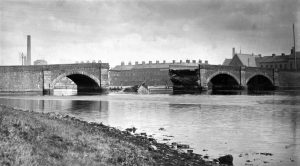
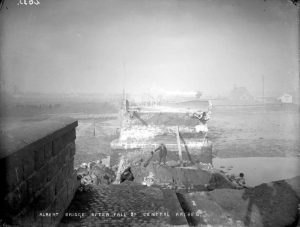
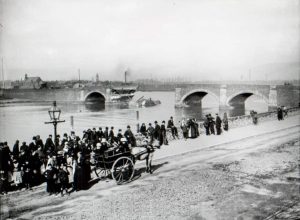 The Ulster Echo newspaper of 16th September 1886 reported:
The Ulster Echo newspaper of 16th September 1886 reported:
The Catastrophe at the Albert Bridge, Recovery of Bodies, Later Particulars – …. The lamentable catastrophe which occurred at the Albert Bridge last night, when the central arch fell, involving the loss of a number of lives, and inflicting injury upon others.
Thankfully, there was only one death in this horrific incident.
Death
John Matthews, 64, night-watchman, married, died on 15th September 1886 at Albert Bridge. His body had been recovered from the bed of the river at 5 o’clock on the morning of 16th September 1886.
An inquest was held later that day with R F Dill M.D., Coroner for the Borough of Belfast presiding.
The Ulster Echo newspaper of 16th September 1886 reported:
James Callaghan, residing in George’s Court East, Lagan Village, stated that he was passing along the bridge from Ballymacarrett in the direction of the town about twenty minutes to eight along with Mrs Maguire (now in hospital). Witness saw a watchman on the bridge; and immediately after he passed him he heard a crash. Witness looked around and saw that the woman Maguire (note 3) had fallen into the chasm created by the breaking of the bridge. The watchman had also disappeared.
The cause of Matthews’ death was found to be “Homicidal injuries. Death instantaneous”. This information was included in the death registration made on 17th September 1886.

Aftermath
The Belfast Corporation Improvement Committee met again on 17th September 1886:
Albert Bridge (Collapse) – The Surveyor reported the action he had taken from the first time his attention had been attracted to the condition of the bridge till its collapse. Moved by Alderman Dixon. Seconded by Councillor Jenkins.

Temporary Wooden Bridge – Specification for the erection of a temporary wooden bridge over the Lagan as a present substitute for the Albert Bridge until arrangements can be made, either for the repair of the old one or the erection of a new Bridge; the width of the temporary Bridge to be 30 feet including an eight foot footpath and that advertisements be published inviting tenders for doing the work before the 1st January; and that the Improvement Committee be instructed to take charge of the matter; also to report to the Council as to whether the old Bridge can or should be repaired or a new one erected.
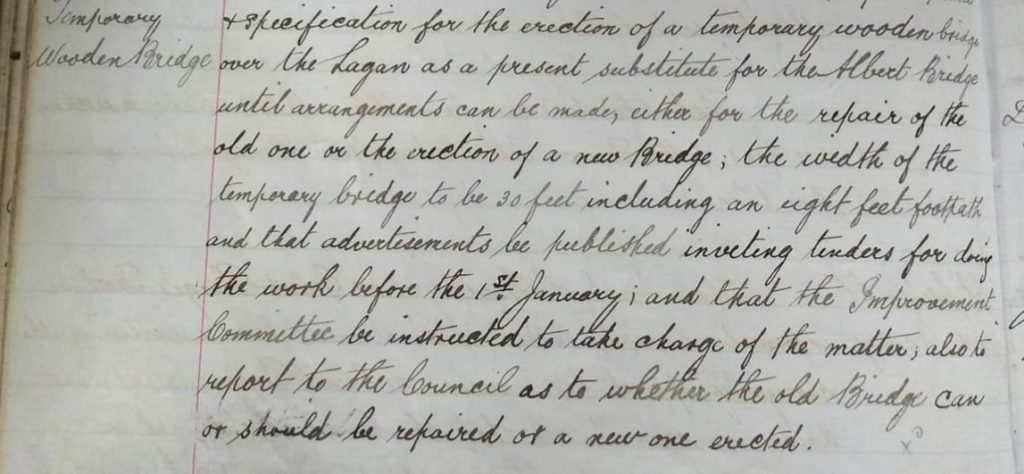 The Belfast News Letter of 20th September 1886 reported:
The Belfast News Letter of 20th September 1886 reported:
There is nothing new in connection with the collapse …. no additional fatalities …. no enquiries have been made for persons missing.
Parliament
The bridge collapse was later raised in Parliament where Hansard records:
21st September 1886 vol 309 cc1113-4 1113
- SEXTON (Belfast, W., and Sligo, S.)
asked the Chief Secretary to the Lord Lieutenant of Ireland, whether any lives have been lost through the collapse of the Albert Bridge, Belfast, on Wednesday evening last; whether the bridge was thronged at the time of the accident; whether it is true, as reported, that a gradual sinking of the structure had been observed for the past two or three weeks; whether the Town Council is responsible for having allowed the continuance of a thoroughfare across the bridge weeks after its collapsing condition became apparent; and, how soon an official inquiry will be held?
THE CHIEF SECRETARY (SIR MICHAEL HICKS-BEACH) (Bristol, W.)
So far as is known one life was lost through this accident. Fortunately, it is not a fact that the bridge was thronged at the time. It is, I understand, true that a gradual sinking had previously been observed; but the immediate collapse of the bridge was not apprehended. I am advised that the question of responsibility is one of law, which must be decided in a Court of Justice, if raised. I am not aware that there is any obligation on the Government to institute an official inquiry; but I shall look further into this matter.”
New Bridge
This new bridge, of granite with three cast-iron arches was designed by Mr J. C. Bretland, the Borough Surveyor of Belfast at the time, and was constructed by Messrs Henry of Belfast on behalf of Belfast Corporation, at a cost of £36,500 was built in 1888/90. All of the cast iron including the decorative lampposts were made in Derby by Andrew Handyside & Co. It was opened in 1890 and the name Albert Bridge was kept, but now in honour of Queen Victoria’s grandson, Prince Albert Victor, who had laid a foundation stone in 1889.
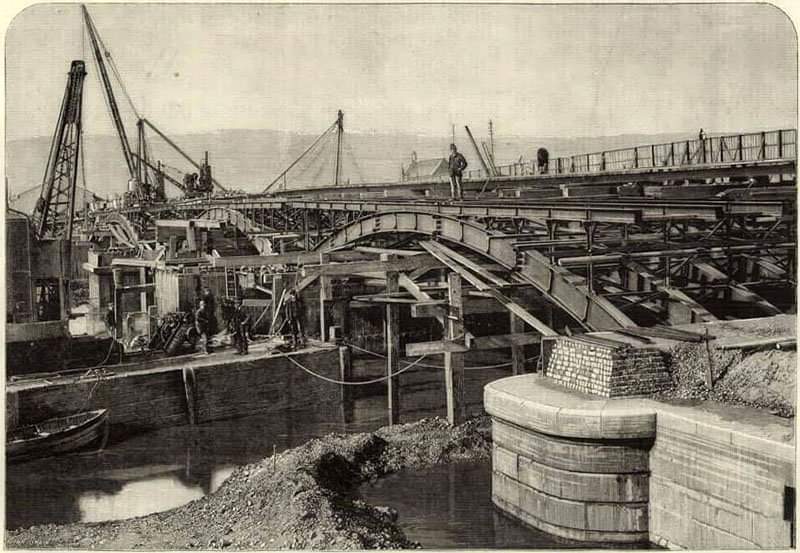
Notes
(1) The author was given the minutes book of the Belfast Corporation Improvement Committee for the period from 20th August 1884 to 21st March 1888. It had been found in a skip.
(2) Sir Edward Harland Bt, Mayor 1885 to 1888.
(3) The Northern Whig of 23rd August 1916 reported on a court case:
An old woman, named Bridget Maguire was charged with an assault. The prosecutor advised the court that the prisoner was nearly lost in the Albert Bridge disaster in 1886, being rescued by police from the debris floating in the Lagan after much difficulty.
